Helmetta:
From Snuff to Snuffed Out
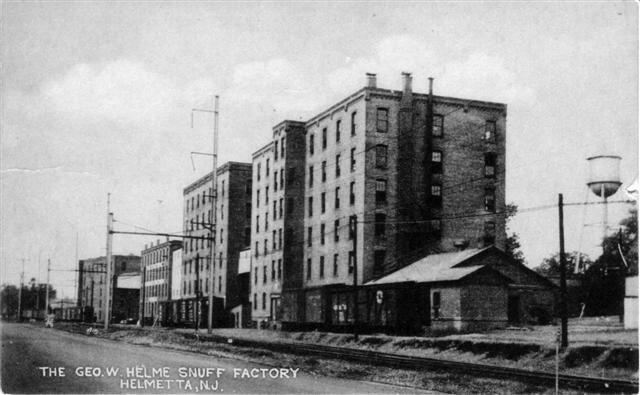
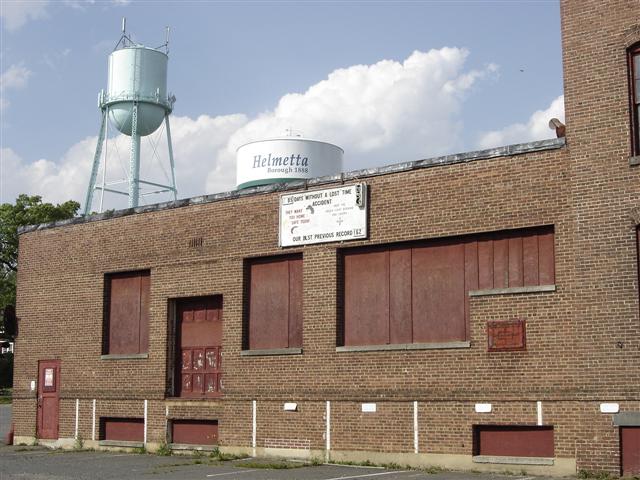
Editor's Note: This is Part II of a two part series looking at the decline of small town America, with focus this month
on the Borough of Helmetta - an unprecented move made by the Jamesburg Network. This look at the Helme Snuff Mill reflects
upon its history and current status, which sadly, will not be around for much longer. Therefore, it is now the time to
enjoy the historic snuff mill before it vanishes forever...
Helmetta is facing a crossroads in its history. Over one hundred years ago, a man by the name of George Washington
Helme had a dream to build a community around a factory. He accomplished that, founding Helmetta, named after his family
surname ("Helme") and his daughter Antoinette ("Etta"). However, in 2005, could Mr. Helme imagine that his proud industrial site is vacant and about to
be torn down? The man who made his vision become a reality (and an entire town) is about to see it fade faster
than imagined, for the sake of progress.
The Man Behind the Snuff
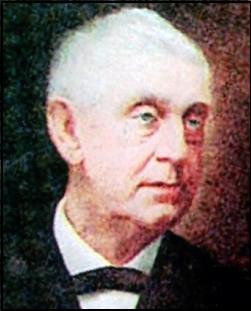 Although Helmetta was incorporated as a municipality in 1888, the community dates back to about 1880 when George W. Helme,
a former New Orleans lawyer and Major-General in the Confederate Army, bought land between Jamesburg and Spotswood, which
today is Helmetta. On this land he would build his snuff mill and 105 homes for workers. George W. Helme was born
May 18, 1822 in Kingston, Pennsylvania. Born to a poor family, George quit school at the age of sixteen and began working.
After a series of jobs, Helme moved to Shreveport, Louisana, where his brother lived, and became a member of the bar in 1851.
He opened a law office in 1852. In 1858, he married Margaret Appleby, whose father, Leonard Appleby of Spotswood, was working
a snuff and tobacco operation at Railroad Mills, which is rumored to be the current site of the Helmetta snuff mill,
and the site of a distillery in the early 1800s. In 1850, Appleby's Railroad Mills snuff mill had eight workers, and there
were five buildings scattered over the area now comprising the borough of Helmetta.
Although Helmetta was incorporated as a municipality in 1888, the community dates back to about 1880 when George W. Helme,
a former New Orleans lawyer and Major-General in the Confederate Army, bought land between Jamesburg and Spotswood, which
today is Helmetta. On this land he would build his snuff mill and 105 homes for workers. George W. Helme was born
May 18, 1822 in Kingston, Pennsylvania. Born to a poor family, George quit school at the age of sixteen and began working.
After a series of jobs, Helme moved to Shreveport, Louisana, where his brother lived, and became a member of the bar in 1851.
He opened a law office in 1852. In 1858, he married Margaret Appleby, whose father, Leonard Appleby of Spotswood, was working
a snuff and tobacco operation at Railroad Mills, which is rumored to be the current site of the Helmetta snuff mill,
and the site of a distillery in the early 1800s. In 1850, Appleby's Railroad Mills snuff mill had eight workers, and there
were five buildings scattered over the area now comprising the borough of Helmetta.
 In 1866, Helme formed a partnership with his brother-in-law, Jacob Charles Appleby, over the Railroad Mills property.
Helme became the sole owner in 1879. He apparently continued the Railroad Mills operation until the late-1800s, when he
bought the property that is today's snuff mill district and incorporated the George W. Helme Company in 1884 with stock
of $500,000. On the morning of June 13, 1893, Helme's wife, Margaret, son, George A., and daughter-in-law, left for the
Chicago World's Fair. Helme stood behind in Helmetta. About 7:00 P.M., Helme sat on the front porch of his mansion at
11 High Street. He complained of feeling ill to a snuff mill employee who had stopped to talk. Suddenly he fell back
in his chair, dying unexpectedly of a heart attack.
In 1866, Helme formed a partnership with his brother-in-law, Jacob Charles Appleby, over the Railroad Mills property.
Helme became the sole owner in 1879. He apparently continued the Railroad Mills operation until the late-1800s, when he
bought the property that is today's snuff mill district and incorporated the George W. Helme Company in 1884 with stock
of $500,000. On the morning of June 13, 1893, Helme's wife, Margaret, son, George A., and daughter-in-law, left for the
Chicago World's Fair. Helme stood behind in Helmetta. About 7:00 P.M., Helme sat on the front porch of his mansion at
11 High Street. He complained of feeling ill to a snuff mill employee who had stopped to talk. Suddenly he fell back
in his chair, dying unexpectedly of a heart attack.
According to The Early Snuff Mills of New Jersey, "At the time of his death, Helmetta was a laid-out town with a
population of 500 persons, many from Spotswood and Jamesburg, which replaced the early snuff (mills) and sawmills.
There were well-cared-for streets, and the town was on the Jamesburg branch of the Pennsylvania Railroad. Through Mr.
Helme's energy and business ability, these things had been accomplished. He had nurtured the village from a sleeply place
of two houses and a mill or two, known as Railroad Mills, into a prosperous community.
George W. Helme did not limit his activities to the snuff mill. At the time of his death, he was a member of Helmetta's
governing body, the Borough Commission. At the State Reform School (later known as the State Home for Boys and currently
known as the Training School for Boys) in Monroe Township, Helme was a member of its Board of Trustees and served time
as president of the board.
On June 16, 1893, the day of Helme's funeral, the snuff mill buildings were draped in mourning. A special car of the
Pennsylvania Railroad left Jersey City at 9:10 A.M. to carry mourners to Helme's 11:00 A.M. funeral. Reportedly, 1,500
persons attended. Helme is interred in Fernwood Cemetery, Jamesburg. Newspapers reported Helme was the wealthiest man in
Middlesex County, and suppossedly the second wealthiest man in New Jersey. He left behind an estate estimated to be five
million dollars.
After Helme's death, his son, George A. Helme, became president and chairman of the board of the snuff mill company. He
continued to build the company and placed its stock on the New York Stock exchange. Interestingly enough, he married
Mary Townsend Buckelew of Jamesburg. Together they had three children. The last Helme to serve as director of the company
was James B. Helme, son of George A. He held this position until his death in 1956.
The Snuff Mill District
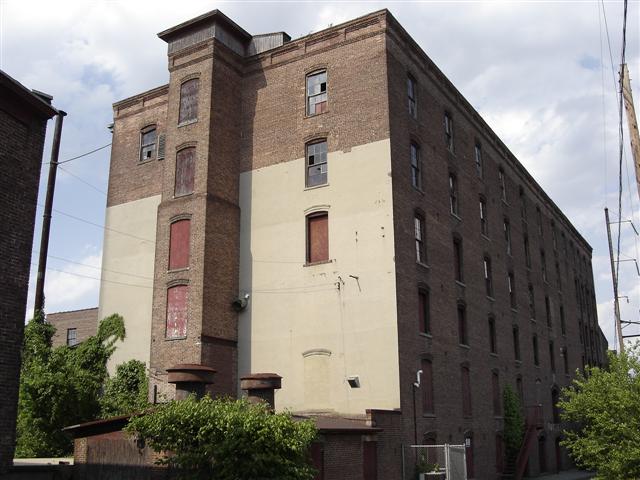 In 1980, the George W. Helme Snuff Mill District was named to both the State and Federal Registers of Historic Places,
February 1 and August 15, respectively. The Railroad Avenue and John Street historic district houses, for the most part,
were workers houses, mostly built in the 1890s. All houses appear the same, except one large residential structure at
1 Railroad Avenue, which is the former company-operated Avon Inn, which was a boarding house and hotel. The Helmetta
railroad station, which stood on Railroad Avenue along the tracks between the two railroad crossings, operated as a
passenger station until passenger service ended around World War II, but continued as a freight station until 1962 or 1963.
Around 1963, the station was moved to Krygier's Nursery on Cranbury Road in East Brunswick until the 1990s when it was
torn down.
In 1980, the George W. Helme Snuff Mill District was named to both the State and Federal Registers of Historic Places,
February 1 and August 15, respectively. The Railroad Avenue and John Street historic district houses, for the most part,
were workers houses, mostly built in the 1890s. All houses appear the same, except one large residential structure at
1 Railroad Avenue, which is the former company-operated Avon Inn, which was a boarding house and hotel. The Helmetta
railroad station, which stood on Railroad Avenue along the tracks between the two railroad crossings, operated as a
passenger station until passenger service ended around World War II, but continued as a freight station until 1962 or 1963.
Around 1963, the station was moved to Krygier's Nursery on Cranbury Road in East Brunswick until the 1990s when it was
torn down.
Separating the High Street and Railroad Avenue-John Street residential areas from each other are the actual factory buildings.
Enormous farm warehouses once filled the now vacant lots northwest of the factories. These wooden warehouses, known as the
"hoggies" were demolished around the late 1970s or early 1980s.
On Ericson Avenue and Club Drive are workers houses built in the early 20th century. When the snuff mill district was named
to the State and Federal Registers, the Club Hall, a former carriage house (later used as a movie house, then a
recreation/community center), was still standing. The building was razed in 1987. Also on Ericson Avenue was the Helmetta Club,
a socially-significant structure that stood until 1963. The Helmetta Club operated from 1907 to about 1935. It then became
a residence until it was demolished by the snuff mill for economic reasons.
One hundred seventeen buildings, including eight mid-twentieth century buildings, such as the Helmetta Fire Department
headquarters (built 1953, demolished 1999) and Post Office (built 1967), were originally included in the historic district.
Other properties of note in the historic district include:
- Snuff mill factories, built in various sections from about 1877 to 1948.
- Boiler house, Main Street.
- Coal trestle, Main Street.
- Pump house, Main Street.
- Carpentry-type shop, Main Street. This building served as Borough Hall from 1934-1981. Demolished.
- Public School, 60 Main Street. The school closed in July, 1979 and became Borough Hall in 1981.
- George W. Helme's Estate, Holly House, 11 High Street. Demolished 2002.
- Olivia Antoinette "Etta" Helme Herberts estate, High Street.
- Helmetta General Store, 66 Main Street.
- Avon Inn, 1 Railroad Avenue.
- St. George's Episcopal Church, 56 Main Street. Constructed 1855.
- Holy Trinity Roman Catholic Church. Constructed 1911.
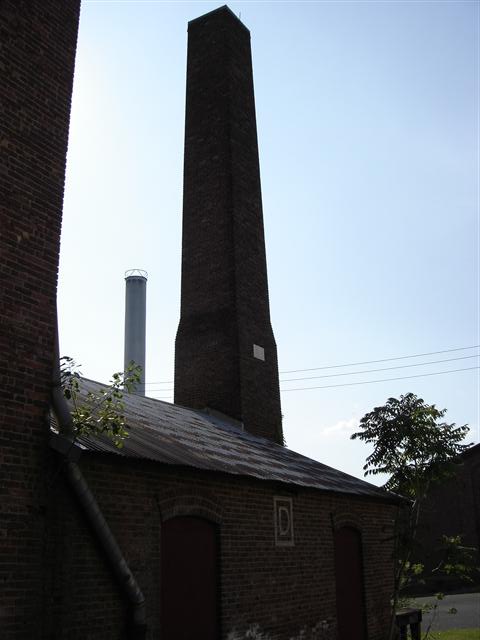

In 1910, the snuff mill employed 500. In 1925, the snuff mill was the largest in the world. The mill had 400 workers in
1934 and 379 in 1943. Beginning in about 1952, the snuff mill was modernized, including the installation of labor-saving
machinery. From 1935 to 1962, the Helmetta operation employed as little as 350 persons to as many as 450, with approximately
50 brands of snuff being produced around 1935 to about 40 brands in 1962. In 1962, the bulk of Helmetta's snuff was marketed
in Southern states; about one-third of American-used dry snuff was made in Helmetta. In 1988, the Helmetta snuff mill was
the world's largest sweet snuff producer.
Today, the mill property sits vacant, awaiting its final demise. Slowly through the years many different buildings have
been lost and presently the entire site will be lost due to history's enemy, progress. Thanks to the effort of the
Helmetta Historical Society, they have recovered some of the leftover items and videotaped a walkthrough. Before the factory
comes down, they have a final walkthrough planned.
So what's in store for the old snuff site?

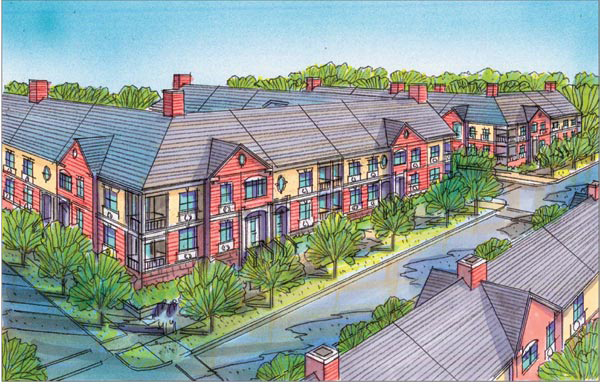
The entire snuff mill property has been divided into five parcels. The project is to include 233 age-restricted housing units on parcels 2, 3, 4 and 5, with parcel 1
designated for open space and recreation that can be used by all borough residents. The redevelopment company, Kaplan, plans to build tennis and basketball courts on parcel 1. The housing
will include 190 multi-family units, each at 1,100 square feet, and 43 townhouses at 2,500 square feet each. The multi-family buildings will be three stories high, and
the townhouses will be no higher than 2.5 stories. Parcel 5 will include a 13,000-square-foot retail establishment on the ground floor, with about 20 residential units
above it. There will also be a 3,000-square-foot community center on the site.
According to a resolution passed by the Helmetta Borough Council, all the snuff mill buildings on the property must be demolished within six months from the
developerís acquisition of the land from the current owner. The resolution requires that construction of the new development also begin within six months of the
acquisition of the property, providing that the site and concept plans have obtained the necessary approvals. The first phase of construction, which will include at
least 60 of the 233 residential units, must be completed within 24 months of the start of construction. All construction must be completed within 42 months.
While we cannot stop the demolition of these historic structures, keep in mind that does not mean their history should not continue to be celebrated. Over 100
years ago a man had a dream for a community. That community stood the test of time and now it is up to the officials in Helmetta to make certain that Mr. Helme's
spirit and enthusiasm remains in whatever goes up where his momuments to early American industrial history once stood.
If you are in the Jamesburg area from June 12 - September 11, 2005, stop at Lakview Mansion to see the temporary display
"Helmetta: From Snuff to Snuffed Out." The exhibit features items recovered from the Helme Snuff Mill during a recent tour,
Helme tobacco products, historical photographs of the mill district, and memorabilia donated from eBay sellers. Various varieties and
sizes of snuff tins, bottles, and cartons (most still filled with snuff!), past and present photographs from the inside of the factory, and an
original window and bench are included in the display. Lakeview Mansion is open the second and fourth Sunday of each month from
2:00 - 4:00 P.M.
Recent Video and Media
Recent Newspaper Articles
Continue to Helmetta: From Snuff to Snuffed Out Photo Page
Excerpts taken from: "Borough of Helmetta, 1888-1988" by Joseph Sapia, 1988.
Edited and adapted by Thomas C. Bodall, 2005.
New Snuff Mill site photos courtesy of www.helmettaboro.com
Feel free to E-Mail the Jamesburg Network and share your opinion and comments!




 Although Helmetta was incorporated as a municipality in 1888, the community dates back to about 1880 when George W. Helme,
a former New Orleans lawyer and Major-General in the Confederate Army, bought land between Jamesburg and Spotswood, which
today is Helmetta. On this land he would build his snuff mill and 105 homes for workers. George W. Helme was born
May 18, 1822 in Kingston, Pennsylvania. Born to a poor family, George quit school at the age of sixteen and began working.
After a series of jobs, Helme moved to Shreveport, Louisana, where his brother lived, and became a member of the bar in 1851.
He opened a law office in 1852. In 1858, he married Margaret Appleby, whose father, Leonard Appleby of Spotswood, was working
a snuff and tobacco operation at Railroad Mills, which is rumored to be the current site of the Helmetta snuff mill,
and the site of a distillery in the early 1800s. In 1850, Appleby's Railroad Mills snuff mill had eight workers, and there
were five buildings scattered over the area now comprising the borough of Helmetta.
Although Helmetta was incorporated as a municipality in 1888, the community dates back to about 1880 when George W. Helme,
a former New Orleans lawyer and Major-General in the Confederate Army, bought land between Jamesburg and Spotswood, which
today is Helmetta. On this land he would build his snuff mill and 105 homes for workers. George W. Helme was born
May 18, 1822 in Kingston, Pennsylvania. Born to a poor family, George quit school at the age of sixteen and began working.
After a series of jobs, Helme moved to Shreveport, Louisana, where his brother lived, and became a member of the bar in 1851.
He opened a law office in 1852. In 1858, he married Margaret Appleby, whose father, Leonard Appleby of Spotswood, was working
a snuff and tobacco operation at Railroad Mills, which is rumored to be the current site of the Helmetta snuff mill,
and the site of a distillery in the early 1800s. In 1850, Appleby's Railroad Mills snuff mill had eight workers, and there
were five buildings scattered over the area now comprising the borough of Helmetta.
 In 1866, Helme formed a partnership with his brother-in-law, Jacob Charles Appleby, over the Railroad Mills property.
Helme became the sole owner in 1879. He apparently continued the Railroad Mills operation until the late-1800s, when he
bought the property that is today's snuff mill district and incorporated the George W. Helme Company in 1884 with stock
of $500,000. On the morning of June 13, 1893, Helme's wife, Margaret, son, George A., and daughter-in-law, left for the
Chicago World's Fair. Helme stood behind in Helmetta. About 7:00 P.M., Helme sat on the front porch of his mansion at
11 High Street. He complained of feeling ill to a snuff mill employee who had stopped to talk. Suddenly he fell back
in his chair, dying unexpectedly of a heart attack.
In 1866, Helme formed a partnership with his brother-in-law, Jacob Charles Appleby, over the Railroad Mills property.
Helme became the sole owner in 1879. He apparently continued the Railroad Mills operation until the late-1800s, when he
bought the property that is today's snuff mill district and incorporated the George W. Helme Company in 1884 with stock
of $500,000. On the morning of June 13, 1893, Helme's wife, Margaret, son, George A., and daughter-in-law, left for the
Chicago World's Fair. Helme stood behind in Helmetta. About 7:00 P.M., Helme sat on the front porch of his mansion at
11 High Street. He complained of feeling ill to a snuff mill employee who had stopped to talk. Suddenly he fell back
in his chair, dying unexpectedly of a heart attack.
 In 1980, the George W. Helme Snuff Mill District was named to both the State and Federal Registers of Historic Places,
February 1 and August 15, respectively. The Railroad Avenue and John Street historic district houses, for the most part,
were workers houses, mostly built in the 1890s. All houses appear the same, except one large residential structure at
1 Railroad Avenue, which is the former company-operated Avon Inn, which was a boarding house and hotel. The Helmetta
railroad station, which stood on Railroad Avenue along the tracks between the two railroad crossings, operated as a
passenger station until passenger service ended around World War II, but continued as a freight station until 1962 or 1963.
Around 1963, the station was moved to Krygier's Nursery on Cranbury Road in East Brunswick until the 1990s when it was
torn down.
In 1980, the George W. Helme Snuff Mill District was named to both the State and Federal Registers of Historic Places,
February 1 and August 15, respectively. The Railroad Avenue and John Street historic district houses, for the most part,
were workers houses, mostly built in the 1890s. All houses appear the same, except one large residential structure at
1 Railroad Avenue, which is the former company-operated Avon Inn, which was a boarding house and hotel. The Helmetta
railroad station, which stood on Railroad Avenue along the tracks between the two railroad crossings, operated as a
passenger station until passenger service ended around World War II, but continued as a freight station until 1962 or 1963.
Around 1963, the station was moved to Krygier's Nursery on Cranbury Road in East Brunswick until the 1990s when it was
torn down.



